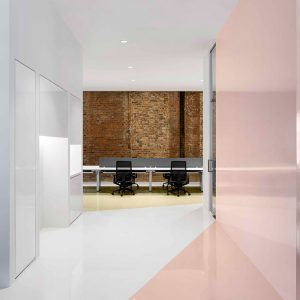No matter what industry you’re in, a well-designed, modern workspace will drastically improve employee productivity. All of us appreciate the value of good interior design and architecture, as it improves much more than just aesthetics. Good quality design has the power to improve productivity, work rate, health and well-being. Here we look at how office design affects employees.
Natural Light Reduces Stress and Improves Vitality
Spaces which maximize natural light through large windows make people feel happier and healthier than dark spaces with artificial light. Natural light results in less absenteeism, reduced stress, fewer illnesses and increased employee productivity and alertness. A research study concluded that ‘there is a strong relationship between workplace daylight exposure and office workers’ sleep, activity and quality of life… Those with windows in the workplace receive 173% more white light exposure and slept an average of 46 minutes more per night’.
Open Plan Areas Increase Collaboration
Offices designed with large, open plan spaces encourage staff to work collaboratively and creatively in an inclusive environment. Desks placed side by side hugely improve working relationships and team spirit as staff can easily communicate with one another. Companies such as BE Offices have well-designed open plan offices across the UK which enable businesses to work more effectively and efficiently.

Office Plants Improve Air Quality and Working Environment
Making use of plants in the workplace not only improves air quality, it also has a positive impact on staff health and well-being. Academic studies found that employees are 15% more productive when workplaces are filled with some house plants, as those ‘who actively engage with their surroundings are better workers’.
Plants in the office can reduce stress, anxiety and fatigue and produce cleaner air. They are pivotal in creating a positive working environment.
Using Colour Can Impact Mood and Productivity
Many office spaces stick to neutral color schemes. This is not the wisest choice in a working environment, as bland and boring colors can lead to increased feelings of sadness and depression. The psychologic effects of color choices should be well thought out when interior designing an office space. Oranges and pinks are often great color choices as they evoke feelings of energy, excitement, warmth and enthusiasm. In contrast the color blue can make people feel calm, peaceful and relaxed, which might work well in stressful environments.
Break Out Spaces Increase Productivity
Break-out spaces give staff somewhere that they can switch off and have a real break away from their desk. This can be anything from a separate staff room or kitchen to a corner of a room which is separated using attractive screening. Giving staff an area dedicated to relaxation improves mental state, resulting in much higher productivity.
A well-designed work-place can drastically improve employee performance, satisfaction and well-being. It is important that designers create spaces which are engaging, full of life and light so companies retain their employees.







